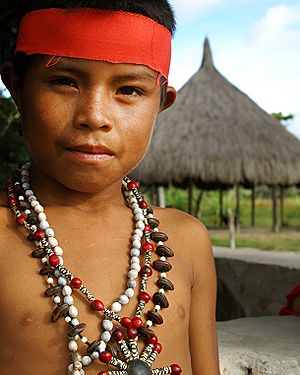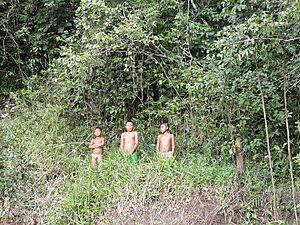Pemon facts for kids

Pemon boy, Venezuela
|
|
| Total population | |
|---|---|
| c. 31,440 | |
| Regions with significant populations | |
| 30,148 (2011) | |
| 792 (2014) | |
| c. 500 | |
| Languages | |
| Pemon, Spanish | |
| Religion | |
| traditional tribal religion, Roman Catholicism | |
The Pemon (also called Pemón) are a group of native people who live in parts of Venezuela, Brazil, and Guyana. They are also known by other names like Arecuna, Aricuna Jaricuna, Kamarakoto, and Taurepang.
Who Are the Pemon People?
The Pemon are part of a larger group of people who speak Cariban languages. This group includes six smaller communities. These are the Arekuna, Ingarikó, Kamarakoto, Tualipang, Mapoyo, and Macushi (also known as Makushi or Makuxi).
Westerners first met the Pemon in the 1700s. Missionaries later helped them learn about Christianity. The Pemon society is based on trading goods. They have a system where everyone is seen as equal, and there isn't one main leader.
In Venezuela, the Pemon live in the Gran Sabana. This is a large grassland area with flat-topped mountains called tepui. The famous Angel Falls, the world's highest waterfall, drops from Auyantepui here. This area is part of Canaima National Park. Money from oil has helped fund projects for Pemon communities in Venezuela. They are also developing ways for tourists to visit their lands and learn about their culture.
In Brazil, about 792 Pemon people live near the borders of Venezuela and Guyana. They live in villages within special areas called Terras Indígenas São Marcos and Raposa Serra do Sol. The Makuxi people, who also speak a Pemon language, live in Brazil and Guyana near the Venezuelan border.
The Pemon Language
The Pemon language is also called Arekuna. It is a Cariban language. Most Pemon people speak it in Venezuela. It is mainly spoken in the Gran Sabana region of Bolívar State. In 2001, about 15,094 people in Venezuela spoke Pemon.
Pemon Myths and Stories
The Pemon people have many rich traditional stories and myths. These stories have blended with their Christian beliefs over time. Pemon myths often talk about gods who live in the flat-topped mountains called tepui. These mountains are special places. They are believed to be home to ancestor spirits called mawari. Living people are not supposed to go there.
A German expert named Theodor Koch-Grunberg was the first non-native person to study Pemon myths and language seriously. He visited Roraima in 1912.
Important Pemon myths explain how the sun and moon came to be. They also tell how the tepui mountains were formed. These mountains rise dramatically from the grasslands of the Gran Sabana. Many stories are about a creator hero named Makunaíma. Makunaíma is sometimes described as one person or as a group of brothers. They are said to be the sons of the sun, Wei, and a woman made of clay.
One story tells how Makunaíma searched for his father, who was held captive by bad spirits. After finding his father, Makunaíma discovered the "tree of the world." When he cut it down, the stump became Mount Roraima. The falling tree caused a huge disaster with floods and fire. Makunaíma then recreated humans. He also turned some people and animals into stone. These stones are part of how the Pemon describe the natural world around them.
Missionary work has influenced Pemon beliefs. For example, Jechikrai is the Pemon name for Jesus Christ.
See also
 In Spanish: Pueblo pemón para niños
In Spanish: Pueblo pemón para niños
- Pemon conflict


